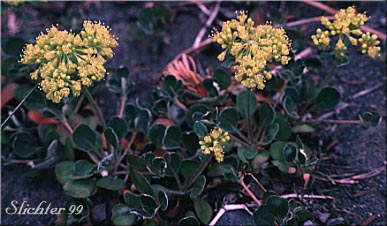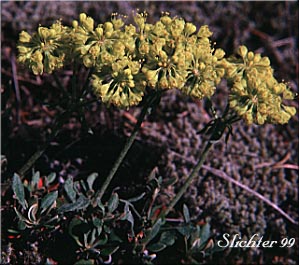

 Characteristics:
Characteristics:
Sulpur Buckwheat is a dwarf, mat forming shrub with short, prostrate to erect stems to 30 cm tall. The plants when prostrate, may be as much as 60 cm wide. The stems lack leaves, and a whorl of leafy bracts may be found directly below the inflorescence (See photo at right.). The leaves are mostly basal, with the blades oval or elliptical in shape with long, thin petioles, and fairly tomentose especially on the lower surfaces. The upper leaf surfaces are often greener. The leaves range from 1-4 cm long and about 5-20 mm wide.
The inflorescence is an open umbel. The flowers are typically creamy, or frequently a light to deep yellow as in the variety shown above.
This is a varied species, found with sagebrush in the lowlands, to exposed alpine ridges, on both rocky and sandy substrates.
A widespread species, Sulphurflower is found from southern British Columbia, south along the eastern edge of the Cascades and Sierra Nevada Mts. to southern California, and eastward to the east side of the Rocky Mts.
This is a pretty wildflower of long bloom period, with interesting foliage which could be used successfully in rockeries or dry, natural garden, especially in the intermountain region. It will survive west of the Cascades, but needs good drainage and perhaps some protection from winter rains.
